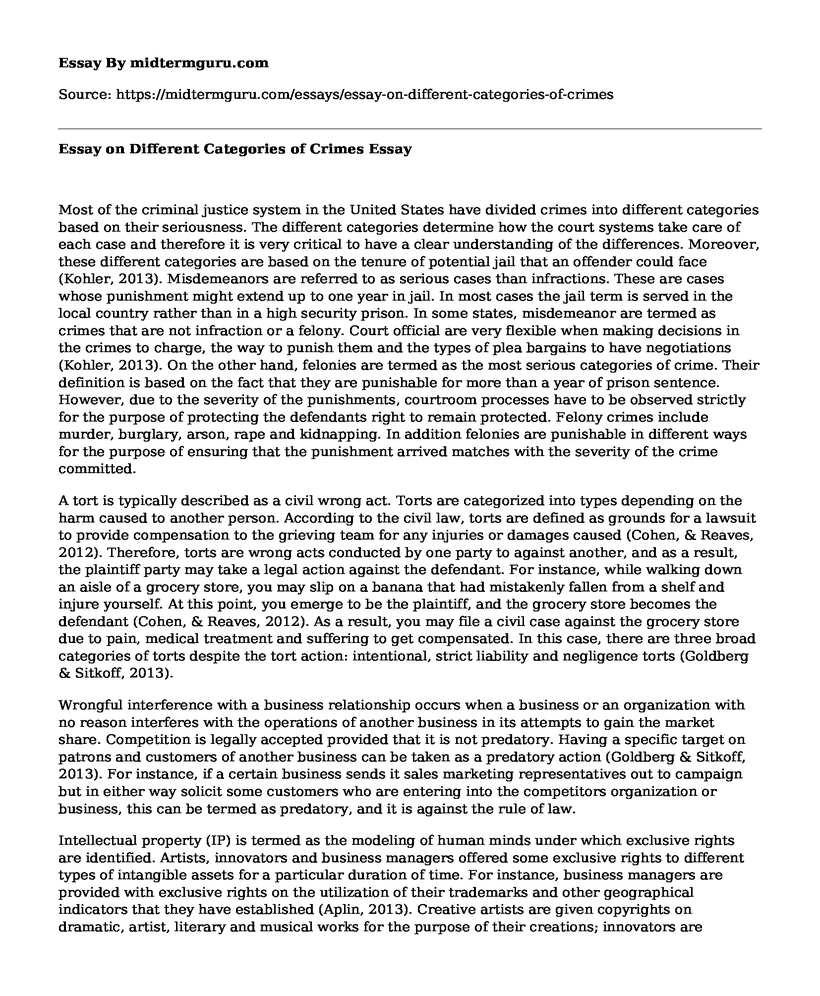Most of the criminal justice system in the United States have divided crimes into different categories based on their seriousness. The different categories determine how the court systems take care of each case and therefore it is very critical to have a clear understanding of the differences. Moreover, these different categories are based on the tenure of potential jail that an offender could face (Kohler, 2013). Misdemeanors are referred to as serious cases than infractions. These are cases whose punishment might extend up to one year in jail. In most cases the jail term is served in the local country rather than in a high security prison. In some states, misdemeanor are termed as crimes that are not infraction or a felony. Court official are very flexible when making decisions in the crimes to charge, the way to punish them and the types of plea bargains to have negotiations (Kohler, 2013). On the other hand, felonies are termed as the most serious categories of crime. Their definition is based on the fact that they are punishable for more than a year of prison sentence. However, due to the severity of the punishments, courtroom processes have to be observed strictly for the purpose of protecting the defendants right to remain protected. Felony crimes include murder, burglary, arson, rape and kidnapping. In addition felonies are punishable in different ways for the purpose of ensuring that the punishment arrived matches with the severity of the crime committed.
A tort is typically described as a civil wrong act. Torts are categorized into types depending on the harm caused to another person. According to the civil law, torts are defined as grounds for a lawsuit to provide compensation to the grieving team for any injuries or damages caused (Cohen, & Reaves, 2012). Therefore, torts are wrong acts conducted by one party to against another, and as a result, the plaintiff party may take a legal action against the defendant. For instance, while walking down an aisle of a grocery store, you may slip on a banana that had mistakenly fallen from a shelf and injure yourself. At this point, you emerge to be the plaintiff, and the grocery store becomes the defendant (Cohen, & Reaves, 2012). As a result, you may file a civil case against the grocery store due to pain, medical treatment and suffering to get compensated. In this case, there are three broad categories of torts despite the tort action: intentional, strict liability and negligence torts (Goldberg & Sitkoff, 2013).
Wrongful interference with a business relationship occurs when a business or an organization with no reason interferes with the operations of another business in its attempts to gain the market share. Competition is legally accepted provided that it is not predatory. Having a specific target on patrons and customers of another business can be taken as a predatory action (Goldberg & Sitkoff, 2013). For instance, if a certain business sends it sales marketing representatives out to campaign but in either way solicit some customers who are entering into the competitors organization or business, this can be termed as predatory, and it is against the rule of law.
Intellectual property (IP) is termed as the modeling of human minds under which exclusive rights are identified. Artists, innovators and business managers offered some exclusive rights to different types of intangible assets for a particular duration of time. For instance, business managers are provided with exclusive rights on the utilization of their trademarks and other geographical indicators that they have established (Aplin, 2013). Creative artists are given copyrights on dramatic, artist, literary and musical works for the purpose of their creations; innovators are normally given protection rights for their trade secrets, patents, private information, industrial designs as well as layout-designs of the integrated circuits for their technologies. Therefore, the integrated property is a valuable asset for every business as it enables the business stakeholders and financial organizations to remain confidence while investing and collaborating with other partners (Aplin, 2013). Apart from creation protection, business managers are given the opportunity to express the value of their IPs in various ways, and they can license out, franchise and transact their intellectual property.
References
Kohler-Hausmann, I. (2013). Misdemeanor Justice: Control without Conviction 1. American Journal of Sociology, 119(2), 351-393.
Cohen, T. H., & Reaves, B. (2012). Felony defendants in large urban counties, 2006. BiblioGov.
Winfield, P. H. (2013). The Province of the Law of Tort. Cambridge University Press.
Goldberg, J. C., & Sitkoff, R. H. (2013). Torts and estates: remedying wrongful interference with inheritance.
Cornish, W., Llewelyn, G. I. D., & Aplin, T. (2013). Intellectual property: patents, copyright, trade marks & allied rights.
Cite this page
Essay on Different Categories of Crimes. (2021, Jun 25). Retrieved from https://midtermguru.com/essays/essay-on-different-categories-of-crimes
If you are the original author of this essay and no longer wish to have it published on the midtermguru.com website, please click below to request its removal:
- Essay Sample on Campus Carry Concealed Handgun Law
- Criminal Law Case Study Critique
- The Unlicensed Reproduction of Copyrighted Media - Paper Example
- A Death in St. Augustine - Critical Essay
- Practitioner Interview With Researcher in the Field of Criminal Law
- The Crime Problem in America - Research Paper
- Factory Workers in Industrial Revolution: Poor Wages, No Rights - Essay Sample







